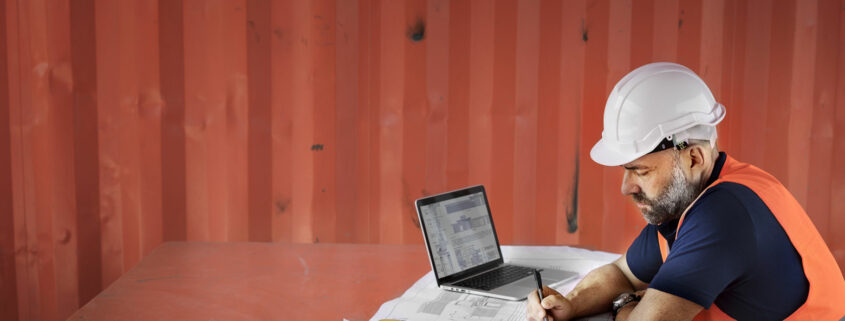A reliable and comprehensive roof asset management plan is essential for commercial business owners and facilities management personnel who want to make sure their property is in optimal shape. Fully complying with all zoning and safety guidelines is essential – and often frustrating – for any business owner, but keeping information organized can help to lessen the stress of knowing the ins and outs of your roofing system(s).
With the right planning process, you can easily manage your assets, prevent depreciation of your property, ensure safety standards are being met, and boost profitability. Let’s take a look at five simple components that will help create an unbeatable roof asset management plan so that you can have peace of mind when it comes to managing your commercial buildings.
Step 1: Document Everything About Your Roof
When you decide it’s time for a roof asset management plan (which is often created to keep commercial roof warranty intact), it’s extremely important to document everything. This means take pictures, notes, and have any records associated with your commercial roof available.
All documentation should be accessible, whether to the building owner or property manager, so that you can make informed decisions about any structural needs or improvements for the commercial building.
Conduct a Roof Inspection
A detailed commercial roof inspection will uncover current and potential issues. Knowing this information at the start of your RAM will help you shape your program.
Teaming up with a professional roofing contractor gives you access to technology that assists in locating hidden problems, such as roof leaks or damaged shingles, that your untrained eye may not find.
Know as Many Details as Possible
As you gather information about your roof, there are key questions you’ll want answered.
-
- How old is your roof?
- What material is your commercial roof system made of (aka what type of roof do you have)?
- What kind of roof maintenance or repairs have been made?
- What is the size of your roof?
- Where is your commercial roof in terms of its life cycle?
It’s also a good idea to make sure you have access to any blueprints, diagrams, or other documents for your roof. The more information you have, the better your RAM will be.
Step 2: Prioritize Your Roof’s Needs
After organizing your roof’s pertinent information, it’s time to create a forecast of what needs to be done. (This is when you prioritize your roofing needs, from short-term maintenance and repairs, to bigger investments including potential replacements.) Keep in mind where your roof is in terms of its service life along with safety concerns and potential disruptions to business when making this list.
By taking this proactive approach, you’ll reduce unplanned expenses by anticipating roofing services, allowing you to make informed decisions on how to extend the life of your roof.
Step 3: Develop a Maintenance Routine
Once you have a timeline for upcoming (or potential) roofing projects, it’s time to incorporate routine maintenance.
Create a detailed schedule for regular maintenance, such as inspecting and repairing flashings, cleaning debris after a weather event, and tending to any small issues or concerns before they grow. Within this routine, you’ll want to add in bi-annual roof assessments by your roofing company.
Room for Change
In your schedule of roofing projects, it’s okay to make adjustments. For example, you may have a professional roofing inspection completed where you find a need to repair or replace an area that you weren’t planning on doing for another 2 years. Following a severe weather event, you may also have to make emergency repairs. So, even though the timeline itself might change, you’ll already have communication protocol in place that will help address unexpected issues.
Step 4: Assemble a Budget
Building a roof asset management program is a great tool to create a budget for your commercial roof. (Not to mention the potential cost savings of proactive maintenance versus reactive repairs.)
Expenditures associated with routine maintenance, preventative maintenance, roof repairs, and even a potential roof replacement can be based on your forecast. Anticipating work as part of your maintenance program will help you identify areas within your budget that can be reallocated.
Step 5: Hire a Professional Roofing Contractor
It makes sense to talk to a professional roofing contractor about your roof asset management plan right off the bat so you don’t lose time (or money) trying to get started. When you work with an organization like TEMA Roofing, you can even get access to a convenient client portal that houses all of this information for you.
Expertise
Professional roofing contractors have the experience needed to assess your commercial roof, and they’re trained to address any roof condition. They know how to identify leaks, deterioration, structural damage, and other issues that you may not recognize.
Beyond that, a professional roofing contractor will help you organize, plan and implement a RAM plan.
Easier Future Work
Working with a professional roofing contractor when creating your roof asset management plan makes it easier in the future for both you and your contractor.
All services and repairs are documented and the information is in one place, making everything from repairs to a new roof that much easier for your contractor (and you, too).
Commercial Roof Consultants Ready to Help
A roof asset management plan is essential for every business, and by incorporating these five components, you can create a successful roof asset management plan that ensures the longevity of your roof. It will save you both time and money in the future! And, as with many things, it’s often best to call on the experts for help.
That’s why TEMA works with you to customize a roof asset management plan that fits your needs. We have more than five decades of experience in roofing services, including providing tailored solutions for all sorts of roofing systems, so don’t hesitate – contact us today! We’re ready to help you implement a successful roof asset management plan.





